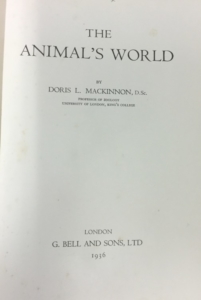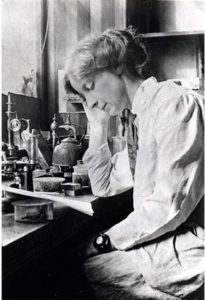Doris Livingstone Mackinnon
Zoologist; Protozoologist
Image © University of Dundee Archive Services
- BORN 30th September 1883, Aberdeen, Scotland, UK
- DIED 10th September 1956, Chelsea, London, England, UK
- WORKED University College, Dundee, Scotland; Liverpool School of Tropical Medicine; 1st Western General Hospital, Liverpool; University War Hospital, Southampton; King’s College, London, England
- HONOURS In 1927, she became the first female Professor at King’s College, London; She was made Fellow of King’s College London in 1939; She was given the title of Emeritus Professor at King’s College, London in 1949
- MINERVA SCIENTIFICA PROJECT Echoes from Northamptonshire, Scottish Superwomen of Science (National Library of Scotland) 2018

Entry by Catherine Booth
Artistic Connections
Doris Mackinnon came from a musical and artistic family. One sister, Lilias, was a professional concert pianist and teacher, and another, Esther, was a noted artist and portrait painter. Doris had a particular interest in Beethoven, and with a thorough knowledge of German, translated the work of Paul Mies which explored the revisions and changes Beethoven made in his compositions. Her translation, Beethoven’s sketches: an analysis of his style based on a study of his sketch-books appeared in 1929, and was praised for having brought lesser-known aspects of Beethoven’s work to an English-speaking audience.
Music
Title: Bats Moths and Biplanes
Composer: Frances M Lynch
Words by: Frances M Lynch and Doris Mackinnon
Written: 12th – 14th May 2020
For: Solo Singer with recorded manipulated voices, Bat clicks, Bi-plane engines and natural sounds.
Performed by: electric voice theatre singers – Frances M Lynch, Jenny Miller, Margaret Cameron, David Sheppard, Julian Stocker and Gwion Thomas
First Performed: Online during the Covid-19 Outbreak for the “Echoes from Northamptonshire” programme at Brixworth Music Festival on 15th May 2020
This music was inspired by the Sywell Aerodrome Women’s Meeting of 1931 which you can see on a British Pathé News video from the day itself Queens of the Air and by the wildlife close by at Pitsford Water Nature Reserve and Brixworth Country Park.
The solo singer describes the race and some of the women pilots who took part that day, including aircraft engineer Dorothy Spicer and Ornithologist & Radiographer Mary Russell, Duchess of Bedford. The text describing the bats is mainly from zoologist Doris Mackinnon’s book, The animal’s world which was based on talks she gave on the radio throughout the 1930s, interspersed with information gleaned from discussions with Wildlife Conservationist Debbie Samwell and Ecologist Mischa Cross.
It was created at Birnam Studios, London as part of electric voice theatre‘s Minerva Scientifica – Connections 2020 project, supported using public funding by the National Lottery through Arts Council England. Frances M Lynch is supported by PRS Foundation’s The Open Fund for Music Creators.
Title: Laura and Doris
Music by: Frances M Lynch
Words by: Frances M Lynch and Clovenstone Primary 6
Written in: 2018
For: Mixed Voices and Guitar
Performed by: The children of Clovenstone School (Primary 6) Catherine Booth (narrator), Herbie Clarke (guitar), Margaret Cameron (mezzo)
“Laura & Doris” is a sing-along song for children developed during workshops at Clovenstone Primary School in Edinburgh in 2017. It is based on the imagined early life of Doris Mackinnon and her next door neighbour in Aberdeen, entomologist Laura Florence. The enthusiasm of the children is catching – so do join in!
CLICK HERE TO DOWNLOAD WORD SHEET FOR LAURA AND DORIS
Title: How Life is Lived in the Animal’s World – Lavender’s Blue
Music by: Frances M Lynch
Additional Music by: Marie Dare, Beethoven, Traditional, Liza Honeyman
Words by: Frances M Lynch, Catherine Booth, Robert Burns, Lady Carolina Nairne, Walter de la Mare
Written in: 2018
For: Speaker, Soprano, Mezzo, 3 girl soloists, and piano
Performed by: Catherine Booth (Narrator), Margaret Cameron (Doris Mackinnon), Priscilla Adebambo (Young Doris Mackinnon), Frances M Lynch (Laura Florence), Ellie Brammer (Young Laura Florence) and Nicole Laidlaw (Lilias Mackinnon).
This mini opera was created for an event at The National Library of Scotland on January 18th 2018 where it was first performed by the same team as part of a project at Clovenstone Primary School, Edinburgh.
It is a reflection on the lives of zoologists, Doris Mackinnon and Laura Florence who lived next door to each other in Aberdeen when they were young girls, and is based on research by Catherine Booth. We imagine that the two scientists wrote to each other until they grew old, and through their letters we learn about their families, work and lives from hog lice, to birds, radio broadcasts to Beethoven and lavender to protozoa!
It includes a full – if interrupted – performance of “The Three Cherry Trees” by Marie Dare for voice and piano, and extracts from Nairne’s “Oh! Rowan Tree!”, Burns’“To a Louse”, Beethoven’s “Für Elise” and “We Shall ne-er meet again” by Liza Honeyman. The Nursery Rhyme “Lavender’s Blue” is used as an important theme.
Education
She graduated BSc from Aberdeen University in 1906, with special distinction in botany and geology, and was awarded the degree of DSc from Aberdeen University in 1914.
She was awarded a Carnegie Research Scholarship in 1906-1907, which allowed her to work with different research teams over the country, including at the Quick Laboratory, Cambridge.
University of Aberdeen awarded her an Honorary LLD in 1943.
Occupations

New protist parasites from the intestine of Trichoptera. (Image from Parasitology Vol. 3, no. 3, September 2010)
Zoological Assistant, then Lecturer, University College, Dundee
In 1909 Doris became Assistant to Professor D’Arcy Wentworth Thompson in the Zoology Department at University College, Dundee, where she produced several papers on the parasites of insects such as caddis flies and dung flies. Professor Thompson was preparing his famous work, On growth and form, showing how mathematical principles influence the shape and appearance of plants and animals in nature, simply because these result in the most efficient arrangement for growth and survival. Doris drew many of the illustrations for this work. In 1916, she was promoted to the post of Lecturer.
Bacteriologist, military hospitals
From the spring of 1916 until 1918, Doris Mackinnon was seconded to military hospitals in Liverpool and Southampton where she worked on the diagnosis and treatment of dysentery and other intestinal infections. She contributed to several articles reporting on various treatments, especially for soldiers returning from the Gallipoli campaign.
Head of Zoology Department, University College Dundee
Returning to Dundee for several months after the war, Doris took charge of the Zoology Department, after Professor D’Arcy Wentworth Thompson moved to St Andrews.

First laboratory of the Liverpool School of Tropical Medicine (1920)
Credit: Wellcome Library, London. Wellcome Images.
(Creative Commons Attribution only licence CC BY 4.0)
Lecturer, then Professor of Zoology, King’s College London
In 1919, Doris Mackinnon became a Lecturer in Zoology at King’s College London, and in 1927 she became Professor, when she succeeded Professor Julian Huxley. This made her the first female Professor at the College.
Broadcaster and Public Speaker
During the 1930s, Doris presented a series of radio programmes on the biology, life and habits of animals, mostly aimed at school pupils, also occasional programmes for the general public. From her student days, she was giving public lectures in all sorts of venues, which, it seems, were both entertaining and informative. These included at least one at the Royal Institution in 1928.
Author
Her radio programmes inspired her book, The animal’s world, published in 1936. She was also the author of over forty scientific articles, most notably on single-celled parasitic organisms. She was writing a textbook on protozoa when she died, and the work was completed by one of her former students, Dr R S J Hawes.
Scientific Achievement

Ciliated Protozoa: Vorticella by bccoer (Image in public domain CC0 1.0)
Her main area of expertise was in the protozoans – tiny single-celled animals which live in water or as parasites. She established a Centre for Protozoology at King’s College London, which was the first non-medical centre devoted to this discipline. She produced many scientific papers on the protozoa throughout her career. The titles of a few of these indicate her specialist knowledge:
- Herpetomonads from the alimentary tract of certain dung-flies (1910)
- On some more protozoan parasites from Trichoptera (1911)
- Observations on trichonymphids (1926-1927)
- A coccidian from the eggs of Thalassema neptuni Gaertner (1937)
- Observations on a monocystid gregarine Apolocystis elongata … (1946)
Two genera of parasitic protozoa, Dorisa and Dorisiella were named after her.
Did You Know?
Doris’s mother founded and managed a home in Aberdeen for unemployed women, so she grew up with an understanding of the plight of less privileged members of the community.
During the First World War, Doris also took an interest in the kinds of games children played outdoors, and wrote several articles in the Manchester Guardian on that subject.
Doris was encouraged to take up science as a career by geologist, Maria Ogilvie Gordon, though Doris took up a different discipline.
While Doris was growing up, her family lived in Queen’s Road, Aberdeen, right next door to the family of Laura Florence. With just a year between them in age, and with similar interests, we would like to think, although with no proof, that the two girls played together, and perhaps were lifelong friends. The piece Laura and Doris (see above), is inspired by this imagined relationship.
An Inspiring Woman
Doris’s obituary called her an inspiring teacher, and an excellent scientific communicator, with a natural ability to explain scientific concepts to young people. She had no patience for anyone who produced careless work, though would forgive misdemeanours such as smoking in forbidden areas.
Along with other radio programmes aimed at adults, we imagine that schoolchildren listened avidly to her radio broadcasts entitled How life is lived. Her subsequent book, The animal’s world, was reviewed in the Irish naturalists’ journal as ‘a book of biology that must be a revelation to all who read it.’
An introduction to the study of Protozoa, the book in which she and Dr Hawes were engaged in at the time of her death, was described in the Quarterly review of biology as ‘entertaining, with information and many off-hand references … to the safaris of the little, the near-great, and the great white hunters in the protozoological literature.’



